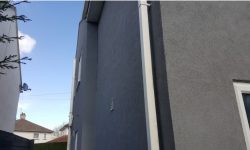Up until about 10 to 20 years ago, if you decided to render your propety, the builder would most likely have used a sand and cement render. Sand and cement render is made by mixing 4 parts sand with 1 part cement and is applied to the substrate at a depth of about 10mm – 15mm. The problem with sand and cement render is that it has no give and no flexibility. Over the course of a year, your home will expand and contract as the weather changes, this of course only minute amounts, however in cold weather the walls of your house will actually shrink and the opposite is true during the summer months.
There’s a reason why building materials and the technology behind their production has changed. Sand and cement render is a very outdated, low-performance solution to creating a decorative finish on your property; these days, thin coat, through-coloured renders and breathable scratch renders are a more popular alternative for installers and homeowners alike. In this post, we’re going to take a look at why sand and cement renders pale in comparison to thin coat render systems.
Sand and Cement renders Crack
The problem with the older sand and cement renders is that as the building changes in size, the sand and cement render won’t move with it. The result is that the old sand and cement render will begin cracking. At first you will begin to see hairline cracks but as time goes on and water begins to get behind the render, it may begin coming off the walls.
One of the ways of limiting the cracking that occurs when sand and cement render is used is the addition of lime to render. When you mix lime in with sand and cement, the finished render coat will have greater flexibility because lime is lightweight and breathable The mixture will not be completely flexible so will still be liable to cracking, but it should be a significant improvement on sand and cement alone. The presence of lime in the render also improves its work-ability, making it easier to spread.
K-Rend also cracks eventually!
To be honest, any thick render system is liable to cracking; it is not just sand and cement render. K-rend and other scratch renders are also more likely to crack than more modern thin-coat renders. It’s not that they are bad products – in fact K-rend is probably the UK’s best selling render – but the unavoidable fact is that any render applied that thickly is more likely to crack.
Thin coat renders are virtually crack proof!
As time has gone on, people have been seeking ‘crack proof’ render finishes. Our thin coat render is just that. It has a flexible fibreglass mesh embedded within the basecoat adhesive and this gives it flexibility. The top coat render is also very flexible. If you put the render as a test on a piece of EPS, you can then flex the EPS and the render will still not crack.
When you consider the overall thickness of the EWI Pro render system then it is much much thinner than K-rend and other scratch renders. The basecoat adhesive is just 6mm thick, and the render topcoat can be as thin as 1mm, this takes the whole system up to a thickness of just 7mm. The flexibility of the components and the fact they are applied in such a thin layer means that the system will genuinely move with the building. This means that the render system will expand with the building during the warmer summer months, and when it gets cold in the winter the render system will shrink.
Which Thin Coat Render is Best for Crack Resistance?
we offer a comprehensive range of thin coat renders, all of which offer flexibility and crack resistance, and can be tinted to create any shade – catering to all tastes! However, each render offers unique benefits:
silicone render
Silicone Render is our premium render. It offers excellent breath-ability and vapour permeability, so that moisture and water vapour can escape from the surface of the render – thereby helping to prevent damp and mould. Silicone Render is also hydrophobic and therefore any water is repelled from the surface of the render. Silicone Render is also unique in that it offers self-cleaning capabilities; this means that the render will actively prevent any build-up of organic growth, therefore maintaining a fresh facade for years to come.
silicone silicate render
Silicone Silicate Render is our most popular hybrid-silicone render. Silicone Silicate Render is our best value render, offering the key benefits of a thin coat render as well as the breathability and vapour permeability that the silicone provides. Silicone Silicate also provides an element of self-cleaning capabilities. This is a great render if performance and functionality at a great price point are key priorities.
Acrylic render
Acrylic Render is our best value render, and is generally most thought of when it comes to coloured render. This is because Acrylic Render holds onto colour pigment really well, providing vibrant and long lasting coloured finishes that are resistant to UV. While Acrylic Render lacks the breathability of the silicones, it is our most impact resistant, so it’s excellent in terms of crack resistance.
Crack proof and maintenance free render!
The beauty of the thin coat render system is that once installed on your property it will genuinely last, with no cracking and no maintenance required. You can install the system on your property and then rest assured knowing the system will last decades!
We do recommend you get qualified installers to install the system though. The reason for this is that since the system is so thin, it is fairly tricky to install. Qualified installers will be able to get a lovely finish – one that you will be able to admire for years to come!
How much does crack proof, thin coat render cost?
In terms of materials, at Fletchers renovations we can provide everything you need for a thin coat render installation. However, often with this kind of work it’s difficult to gauge how much it would cost. For a comprehensive idea of how much materials for a coloured render system could cost, check out our prices section…





















